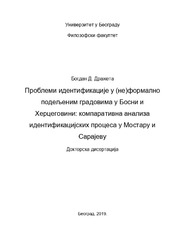Приказ основних података о документу
Problemi identifikacije u (ne)formalno podeljenim gradovima u Bosni i Hercegovini: komparativna analiza identifikacijskih procesa u Mostaru i Sarajevu
Identity building problems in (in)formally divided cities in Bosnia and Hercegovina : ǂa ǂcomparative analysis of the identity building processes in Mostar and Sarajevo
| dc.contributor.advisor | Nedeljković, Saša | |
| dc.contributor.other | Stajić, Mladen | |
| dc.contributor.other | Naumović, Slobodan | |
| dc.contributor.other | Ribić, Vladimir | |
| dc.contributor.other | Milosavljević, Ljubica | |
| dc.creator | Dražeta, Bogdan | |
| dc.date.accessioned | 2021-10-12T10:03:08Z | |
| dc.date.available | 2021-10-12T10:03:08Z | |
| dc.date.issued | 2019 | |
| dc.identifier.uri | http://eteze.bg.ac.rs/application/showtheses?thesesId=7377 | |
| dc.identifier.uri | http://nardus.mpn.gov.rs/handle/123456789/12231 | |
| dc.identifier.uri | http://vbs.rs/scripts/cobiss?command=DISPLAY&base=70036&RID=531051671 | |
| dc.identifier.uri | http://reff.f.bg.ac.rs/handle/123456789/96 | |
| dc.description.abstract | U ovom radu predmet istraživanja biće identifikacijski procesi u Mostaru i Sarajevu, kao (ne)formalno podeljenim gradovima. Njihova podela vezuje se za ratna dešavanja 1992-1995. godine, što je bio predmet naučnih analiza i rasprava u javnosti u proteklom periodu. Biće proučeni svi aspekti (nivoi i vrste) identiteta u odnosu na neformalnu teritorijalnu podelu grada u slučaju Mostara, odnosno formalnu teritorijalnu podelu grada u slučaju Sarajeva. Pored toga, biće istražene i razlike unutar proučavanih grupa, u oba grada. Komparativna analiza dve studije slučaja nastojaće da pokaže kako stanovništvo ovih gradova posmatra pojam granice, i u kojoj meri im simbolička ili fizička linija razgraničenja (ponovo) stvara sopstveni etnički, verski odnosno nacionalni, regionalni, i lokalni identitet. Pored toga, poredbeni okvir omogućiće bolje razumevanje unutargrupunih odnosa kod svih istraženih grupacija, tj. unutrašnjih granica između pripadnika istog naroda, stanovnika jedne regije odnosno urbane celine. Cilj istraživanja je utvrditi da li, u kojoj meri i na koji način, stanovništvo neformalno podeljenog grada (Mostar) drugačije konstruiše svoj kulturni identitet (nacionalni, regionalni i lokalni) u odnosu na stanovništvo formalno podeljenog grada (Sarajevo), putem različitih stavova, razmišljanja i praksi vezanih za tu (ne)formalnu razdvojenost urbane celine. Dakle, kako neformalna (simbolička) a kako formalno-pravna podela urbane teritorije utiče na međuetničku komunikaciju i interakciju u smislu odnosa između nâroda. Građa za ovaj rad prikupljena je tokom obavljanja terenskog istraživanja, u periodu od oktobra 2017. do januara 2019. godine. U radu je učinjena analiza i interpretacija tih materijala, uz navođenje pojedinih primera iz literature, medija i korišćenja određenih statističkih podataka | sr |
| dc.description.abstract | The subject of this research will be the identity building process in Mostar and Sarajevo as (un)officially and (in)formally divided cities. The partition of the two cities is related to events during the war and postwar periods of 1992-1995, as this is an on-going polemic both academically as well as a public opinion ever since. All aspects of the identity will be analyzed in regards to the unofficial territorial division of Mostar, as well as the official territorial division of Sarajevo. In addition, differences amongst the explored ethnic groups within the two cities will be researched. This comparative analysis will endeavor to show how the population of these cities view the idea of borders, and in what way the symbolism of these borders as well as the physical line create a (new) ethnic, religious, national, regional and local identity. The comparative frame will enable a better understanding of the intragroup relations of the examined populations, i.e. the inner symbolic boundaries amongst the same ethnic groups, as well as the population of a region, apropos of the urban entity. The purpose of this research is to determine if and in which way, the population of the unofficially divided city of Mostar constructs its cultural identity (national, regional and local) in regards to the population of the officially divided city of Sarajevo, via different attitudes, thoughts and practices connected to the informal separation of the urban entity. Therefore, how the informal (symbolic) and formal (legal) division of the urban territory influences communication and interaction amongst the ethnic groups. The infrastructure of this research is collected during fieldwork from October 2017 to January 2019. In this research, the analysis and interpretation of these collected materials has been conducted, inducing particular examples from literature, media as well as usage of certain statistic data | en |
| dc.language | sr | |
| dc.publisher | Univerzitet u Beogradu, Filozofski fakultet | |
| dc.relation | info:eu-repo/grantAgreement/MESTD/Basic Research (BR or ON)/177035/RS// | |
| dc.rights | openAccess | |
| dc.rights.uri | https://creativecommons.org/licenses/by/4.0/ | |
| dc.subject | Sarajevo | sr |
| dc.subject | podeljeni gradovi | sr |
| dc.subject | Mostar | sr |
| dc.subject | identitet | sr |
| dc.subject | identifikacija | sr |
| dc.subject | granice | sr |
| dc.subject | etnicitet | sr |
| dc.subject | Bosna i Hercegovina | sr |
| dc.subject | Sarajevo | en |
| dc.subject | Mostar | en |
| dc.subject | identity | en |
| dc.subject | identity building | en |
| dc.subject | ethnicity | en |
| dc.subject | divided cities | en |
| dc.subject | Bosnia and Herzegovina | en |
| dc.subject | borders | en |
| dc.title | Problemi identifikacije u (ne)formalno podeljenim gradovima u Bosni i Hercegovini: komparativna analiza identifikacijskih procesa u Mostaru i Sarajevu | sr |
| dc.title | Identity building problems in (in)formally divided cities in Bosnia and Hercegovina : ǂa ǂcomparative analysis of the identity building processes in Mostar and Sarajevo | en |
| dc.type | doctoralThesis | |
| dc.rights.license | BY | |
| dc.identifier.fulltext | http://reff.f.bg.ac.rs/bitstream/id/2466/93.pdf | |
| dc.identifier.rcub | https://hdl.handle.net/21.15107/rcub_nardus_12231 | |
| dc.type.version | publishedVersion |

